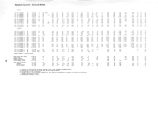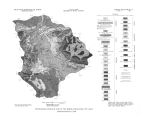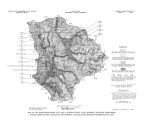| OCR Text |
Show GROUND- WATER SURFACE- WATER RELATIONSHIPS A primary purpose of this study was to evaluate the relation of ground water to surface water in the area and to estimate the effects of increased ground- water withdrawals on streamflow from the area. From the preceding discussions, it is apparent that the ground water in the valley fill and the surface water in the streams that traverse the valleys are intimately related. A part of the ground- water discharge in each valley goes into the streams and a part of the recharge to the aquifer in each valley is derived from surface water. Thus the ground water and the surface water are two parts of a hydrologic system that is in approximate balance, and any changes in the present pattern of water use would change the balance of the system. Any increase in withdrawal of water from the system would ultimately be reflected in decreased stream discharge. Use of ground water in the valleys could be increased, however, with only minimal effects on streamflow. Water that is consumed by evapotranspiration in the marshy bottom lands could be salvaged for other uses by lowering the water table locally and drying up the marshes. Because most of the marshy bottom land is irrigated and maintained as wet meadows, these areas were not distinguished from other croplands in the evapotranspiration calculations given elsewhere in this report, and no estimate of the amount of water that may be salvageable is given. Most of the marshy areas are very near the streams, so careful planning and thorough site investigation would be required to minimize the effect on streamflow of lowering the water table. Moreover, the effects on streamflow of increased withdrawal of ground water from the valley fill would not necessarily be immediate nor pronounced. When water is pumped from an aquifer bordering a stream, part of the water withdrawn from the aquifer is diverted from the stream, either by increasing recharge from the stream or by decreasing discharge to the stream. The percentage of the water pumped from a well that is diverted from the stream is related to the transmissivity and specific yield of the aquifer, the distance of the well from the stream, and the duration of pumping. A graphical method developed by Theis and Conover ( 1963) can be used to estimate the percentage of the water pumped from a well that is diverted from a nearby stream for any combination of aquifer coefficients, distance between well and stream, and duration of pumping. The following examples are given for Heber Valley, assuming an aquifer transmissivity of 10,000 ft3/ d/ ft ( p. 26) and a specific yield of 12 percent ( p. 26). If a well in Heber Valley 1,000 feet from the Provo River were pumped continuously throughout the irrigation season ( 120- 150 days), 85 percent of the water pumped at the end of the season would be water diverted from the river. If the well were 1 mile from the river, however, only about 30 percent of the water pumped at the end of 150 days would be water diverted from the river, and only about 50 percent of the withdrawal at the end of 1 year would be diverted from the river. The diversion from the river would be in the form of a decrease in the rate of ground- water discharge to the river. That part of the pumped water not immediately diverted from the river would be withdrawn from storage in the aquifer. When pumping ceased, the rate of ground- water discharge to the river would not increase to the pre- pumping rate until the water removed from storage in the aquifer had been replaced. Ultimately, all the water removed from the aquifer and used consumptively will have been diverted from the stream. 46 |
































































































